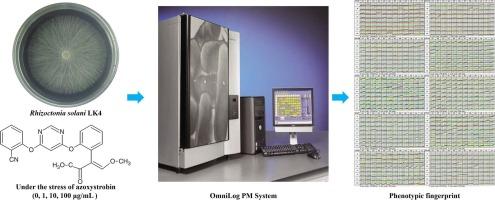表型微阵列™揭示了azoxystrobin对茄枯丝核菌表型特征的影响
IF 4
1区 农林科学
Q2 BIOCHEMISTRY & MOLECULAR BIOLOGY
引用次数: 0
摘要
枯丝核菌是一种对农业生产力构成重大威胁的土壤传播病原体。偶氮杀菌剂是一种有效的杀菌剂,广泛应用于防治番茄枯萎病。本研究利用表型微阵列™系统评估了氮唑菌酯(1、10和100 μg/mL)对茄茄病菌底物利用模式和表型特征的影响。在不暴露偶氮嘧菌酯的情况下,solani在80(83.33%)渗透压和91 (94.79%)pH条件下生长,表现出了显著的代谢能力和强大的环境适应性,利用了97.89%的碳源、98.94%的氮源和100%的磷、硫、营养补充剂和肽氮源。氮嘧菌酯对茄茄代谢能力的影响与其浓度呈非线性相关。在浓度为1、10和100 μg/mL的情况下,azoxystrobin诱导699、855和862个底物表型丧失,229、74和68个底物表型增加。关键下调的KEGG途径包括代谢途径、ABC转运蛋白、次生代谢产物的生物合成、淀粉和蔗糖代谢、嘌呤代谢和氨基酸的生物合成等。值得注意的是,熊果苷和水杨苷在三种氮嘧菌酯浓度下的代谢能力显著增强,参与糖酵解/糖异生和磷酸转移酶系统(PTS),表明它们在杀真菌反应中起作用。这些发现为进一步了解茄属真菌的适应性和偶氮菌酯酶的作用机制提供了新的思路。本文章由计算机程序翻译,如有差异,请以英文原文为准。

Phenotype MicroArray™ reveals the effects of azoxystrobin on the phenotypic characteristics of Rhizoctonia solani
Rhizoctonia solani is a soil-borne pathogen that poses a significant threat to agricultural productivity. Azoxystrobin, a potent fungicide, is extensively utilized for the prevention and control of diseases caused by R. solani. This study evaluated the effects of azoxystrobin (1, 10, and 100 μg/mL) on the substrate utilization patterns and phenotypic characteristics of R. solani using the Phenotype MicroArray™ system. Without azoxystrobin exposure, R. solani demonstrated remarkable metabolic capacity and robust environmental adaptability, utilizing 97.89 % of carbon sources, 98.94 % of nitrogen sources, and 100 % of phosphorus, sulfur, nutrient supplement, and peptide nitrogen sources, growing under 80 (83.33 %) osmotic pressures and 91 (94.79 %) pH conditions. The effect of azoxystrobin on the metabolic capacity of R. solani exhibited a nonlinear correlation with its concentration. At concentrations of 1, 10, and 100 μg/mL, azoxystrobin induced a loss of phenotype in 699, 855, and 862 substrates, and a gain of phenotype in 229, 74, and 68 substrates. The key downregulated KEGG pathways included metabolic pathways, ABC transporters, biosynthesis of secondary metabolites, starch and sucrose metabolism, purine metabolism, and biosynthesis of amino acids, among others. Notably, arbutin and salicin showed significant enhanced metabolic capacity under three azoxystrobin concentrations, involved in glycolysis/gluconeogenesis and phosphotransferase system (PTS), suggesting their role in fungicide response. These findings provide better insights into the adaptability of R. solani and the mechanisms of action of azoxystrobin.
求助全文
通过发布文献求助,成功后即可免费获取论文全文。
去求助
来源期刊
CiteScore
7.00
自引率
8.50%
发文量
238
审稿时长
4.2 months
期刊介绍:
Pesticide Biochemistry and Physiology publishes original scientific articles pertaining to the mode of action of plant protection agents such as insecticides, fungicides, herbicides, and similar compounds, including nonlethal pest control agents, biosynthesis of pheromones, hormones, and plant resistance agents. Manuscripts may include a biochemical, physiological, or molecular study for an understanding of comparative toxicology or selective toxicity of both target and nontarget organisms. Particular interest will be given to studies on the molecular biology of pest control, toxicology, and pesticide resistance.
Research Areas Emphasized Include the Biochemistry and Physiology of:
• Comparative toxicity
• Mode of action
• Pathophysiology
• Plant growth regulators
• Resistance
• Other effects of pesticides on both parasites and hosts.

 求助内容:
求助内容: 应助结果提醒方式:
应助结果提醒方式:


